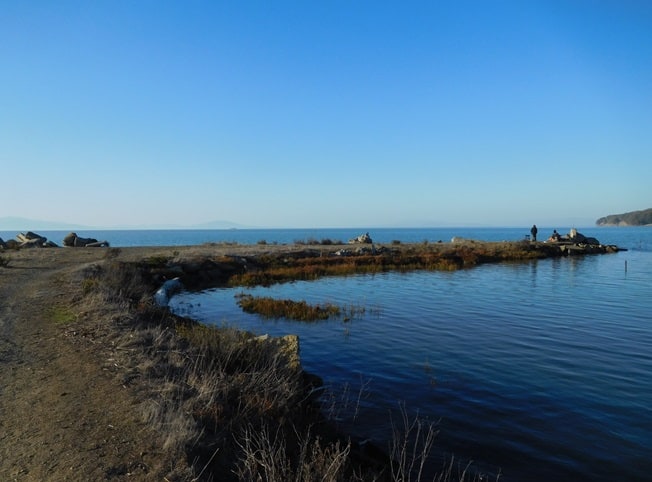Dotson Family Marsh− How We Got This Great Gift
By Maureen Lahiff

Dotson Family Marsh along San Pablo Bay in Richmond is a fantastic place to go birding in fall and winter. Now the southernmost unit of East Bay Regional Park’s Point Pinole Regional Shoreline, restored wetlands and coastal prairie provide abundant food and roosting places for shorebirds and ducks, while the uplands host a number of grassland birds and sparrows. Utility poles and power lines provide perches for raptors, who find good hunting here.
Since Dotson Family Marsh bears witness to an important part of Bay Area history, I’ve written this blog piece as a companion to the Birding Hotspot article I wrote for Golden Gate Bird Alliance’s quarterly print publication The Gull, Summer 2023.
My goal is to deepen visitor’s connection with this land, to increase awareness and appreciation of the remarkable people who worked to keep this area open space, and to provide a bit of background about the Dotson family and why it is truly fitting that this place carries their name. As the East Bay Regional Parks’ 75th anniversary tagline says, Dotson Family Marsh is “ours to keep”.
Ohlone and Miwok peoples used these lands, tending the wild to insure that the plants and animals flourished. Cattle grazed here, tended by native people who were subjugated by Mission San Francisco de Asís, founded in 1776 and commonly known as Mission Dolores because of its location along Dolores Creek in San Francisco. When New Spain became Mexico, this land became part of Rancho San Pablo, granted to Francisco Maria Castro. The 28 square mile land grant (rancho)extended along the coast from Point Pinole south to Kensington. The US honored the Mexican land grants after the Mexican-American War, so the Castro family remained in control of the land.
In 1899, the Santa Fe Railroad established its western terminus in Point Richmond. Standard Oil, the predecessor of Chevron, built a refinery along the coast in 1901. The City of Richmond was incorporated in 1905.
The Kaiser Richmond Shipyards were established in 1941. An influx of black migrants and white migrants from the South, were drawn to the shipyards and neighboring war industries. Temporary housing was provided during World War II. Most of this was torn down after the war ended.
After World War II, Black military veterans could not take advantage of the GI Bill’s educational benefits and were not eligible for mortgage programs that enabled them to purchase homes. In the late 1940s and 1950s, housing developments were segregated, including in California. Parchester Village along San Pablo Bay was an exception. African-American clergy, including Rev. Guthrie John Williams and Rev. Richard Daniel Dotson, worked with the Richmond City Council and developer Fred Parr to create an integrated development of around 400 homes. Despite the clear intent to welcome everyone, most of those purchasing homes in Parchester Village were African-American. The Dotson family was one of the first to move in.
Since many of the Parchester Village families had roots in rural areas in the south, they truly appreciated the easy access to nearby Breuner Marsh. (Named for that Breuner family, the furniture and butcher block maker founded to serve the gold rush and developing San Francisco.) As the years passed, ownership changed and the wetlands became degraded. In the 1970s, the Parchester Village Neighborhood Council successfully fought off development of an airport at the marsh site. Residents wanted open space preserved, and lobbied against large-scale housing developments.
Whitney Dotson continued his father’s community service and activism. He was president of the North Richmond Shoreline Open Space Alliance, which spearheaded the efforts to create parks after dynamite manufacturing at Point Pinole came to an end in the 1960s. The northern areas of Point Pinole Regional Shoreline opened in 1973. (The two major staging areas for the northern part of Point Pinole are named Giant and Atlas after the dynamite companies.)
It took a lot longer to get the Breuner Marsh area set aside as open space. Finally, the East Bay Regional Parks District succeeded in purchasing this land in 2011. In April 2017, the East Bay Regional Parks dedicated the new parking area and improved trails and renamed Breuner Marsh to honor the Dotson Family.
Whitney Dotson served on the East Bay Regional Parks District Board of Directors from 2008 to 2019. He also served on Golden Gate Bird Alliance’s Board of Directors. He received Golden Gate Bird Alliance’s Elsie Roemer Conservation Award in 2007.
In addition to field trips at Dotson Marsh, Golden Gate Bird Alliance has developed a winter docent program for this site as part of our Richmond Initiative. The program didn’t really get a chance to serve the public in 2023 because of the winter rains, but we look forward to recruiting and training docents in the fall.
Come enjoy Dotson Family Marsh. It can be windy, but the trails are level. It’s a great place for families, because you don’t even need to use binoculars to enjoy the shorebirds and ducks.
Sources and resources
https://en.wikipedia.org/wiki/Parchester_Village,_Richmond,_California
Birding Hotspot in Golden Gate Bird Alliance’s quarterly print publication The Gull, Summer 2023.
GGBA blog piece by Ilana DeBare to mark Whitney Dotson’s passing in January 2020. https://goldengatebirdalliance.org/blog-posts/remembering-whitney-dotson/
The Watershed Project’s remembrance of Whitney Dotson https://thewatershedproject.org/whitney-dotson-remembered-champion-of-open-space-for-all/
Rheem Creek Restoration Project, with detailed Land Acknowledgment https://thewatershedproject.org/rheemcreek/https://thewatershedproject.org/land-acknowledgment-rheem-creek/
The official history of the City of Richmond does not mention Parchester Village. https://www.ci.richmond.ca.us/112/History-of-Richmond
The East Bay Regional Park District’s website is ebparks.org
Maureen Lahiff leads field trips and teaches adult ed classes for Golden Gate Bird Alliance, including a late fall course on waterbirds and shorebirds. She developed the training for our new winterdocent program at Dotson Marsh. Maureen also serves as the chair of Golden Gate Bird Alliance’s Adult Ed Committee, which coordinates our adult ed classes and monthly speaker series. Reach her at mlahiff@goldengatebirdalliance.org
